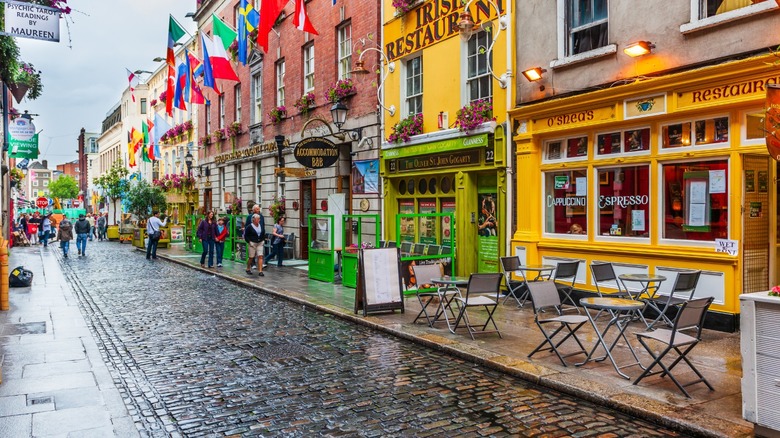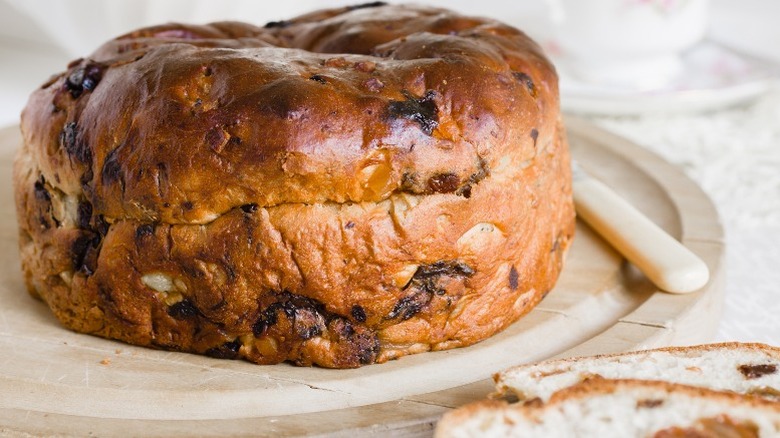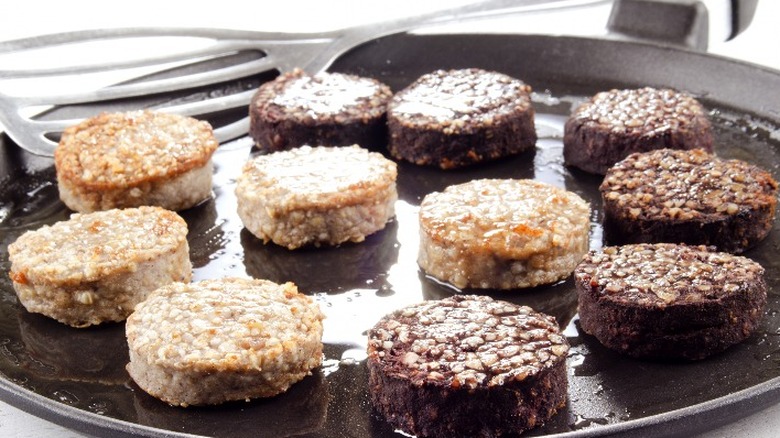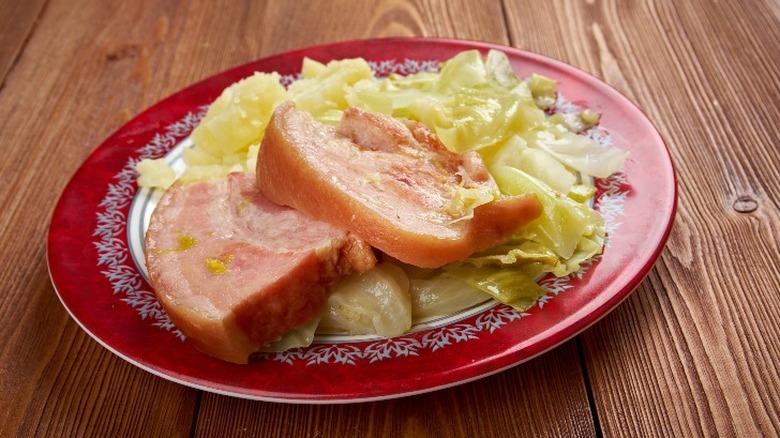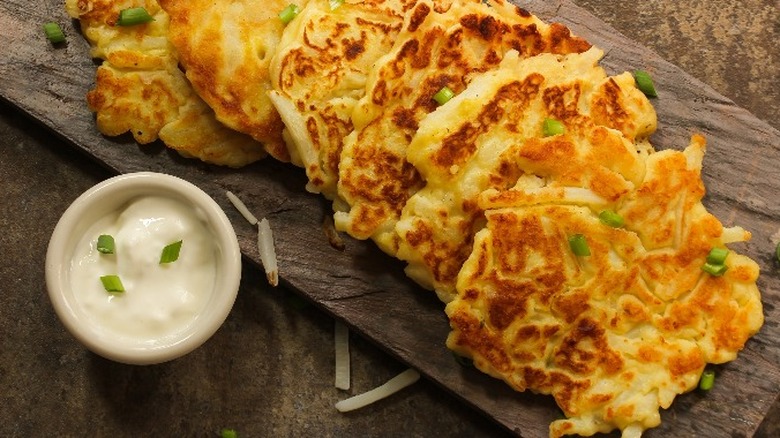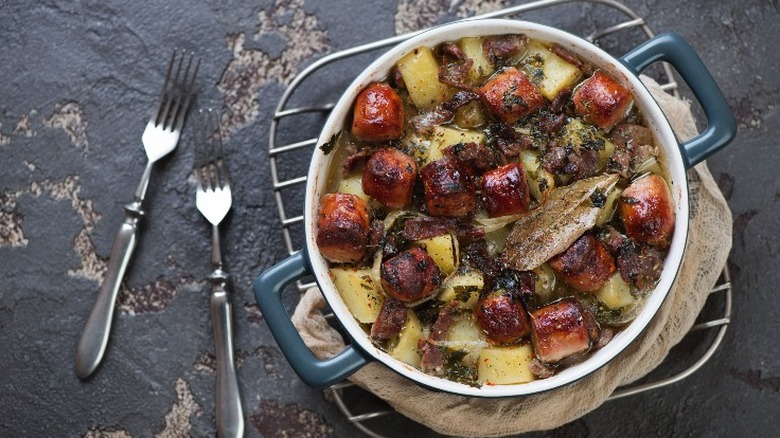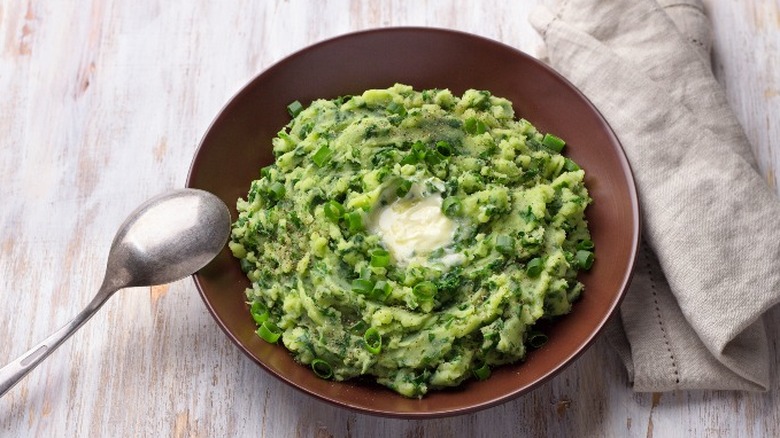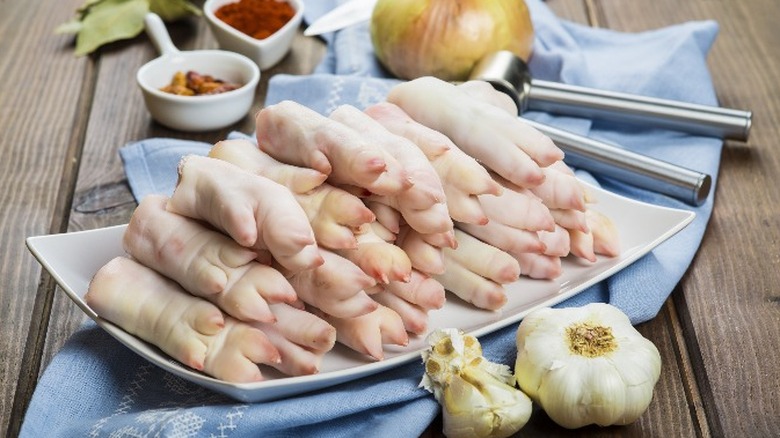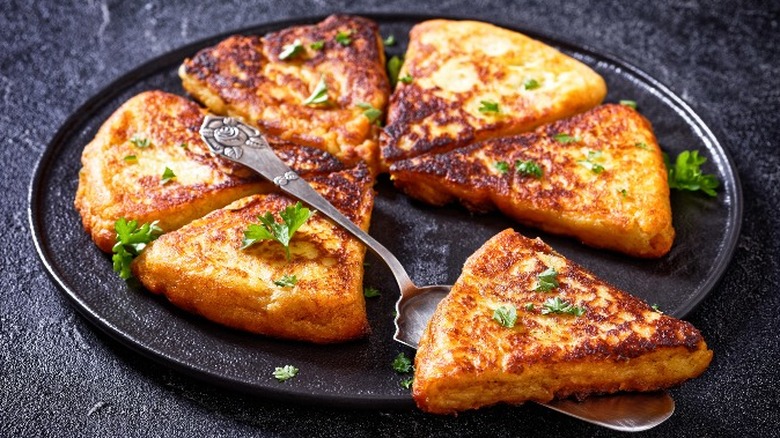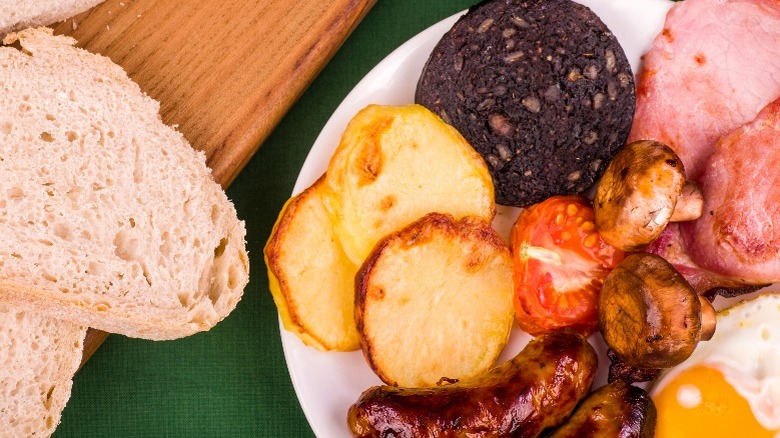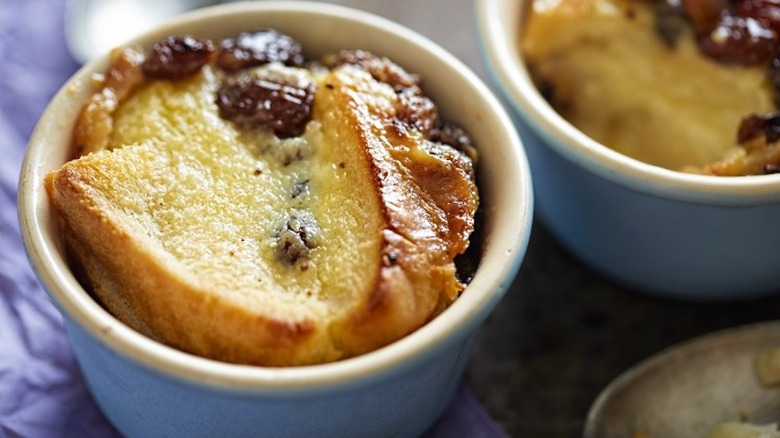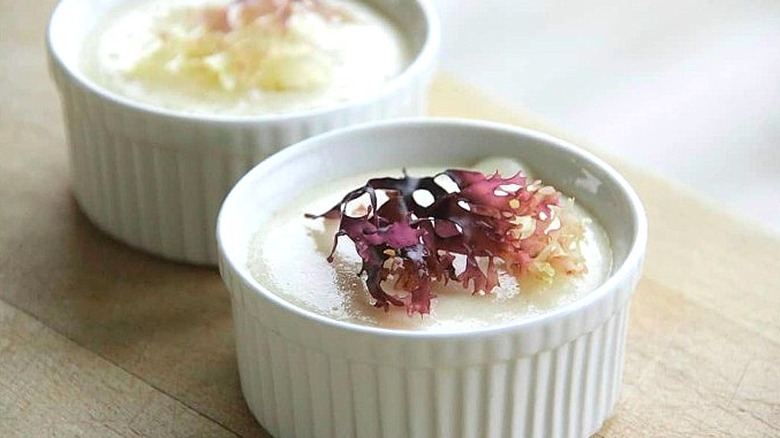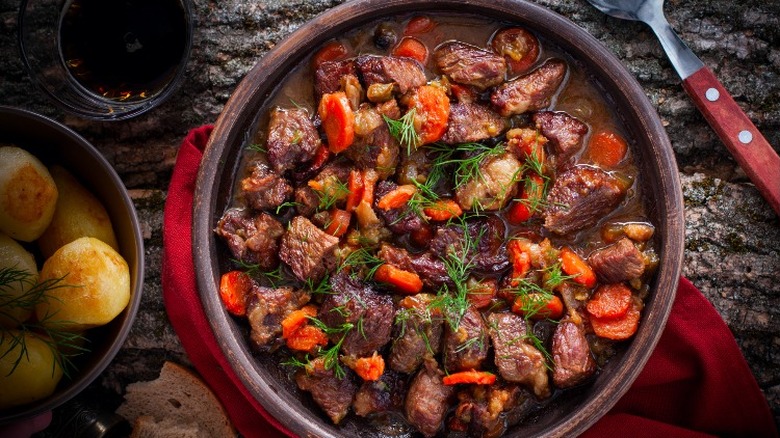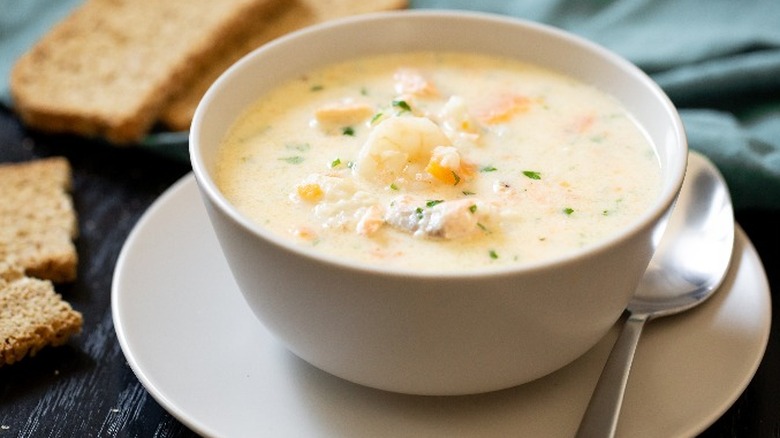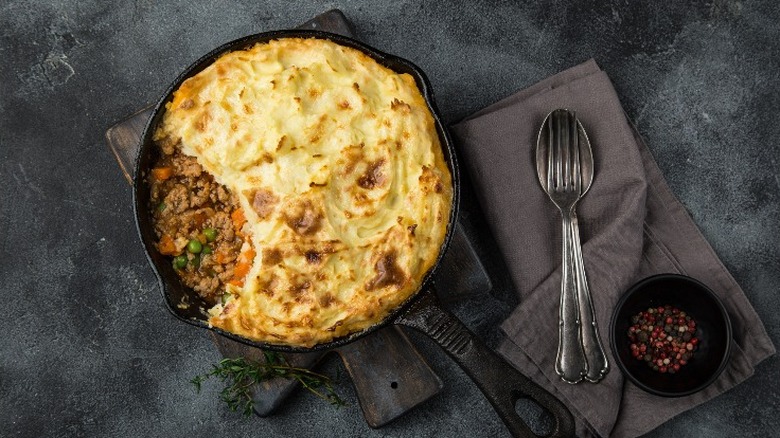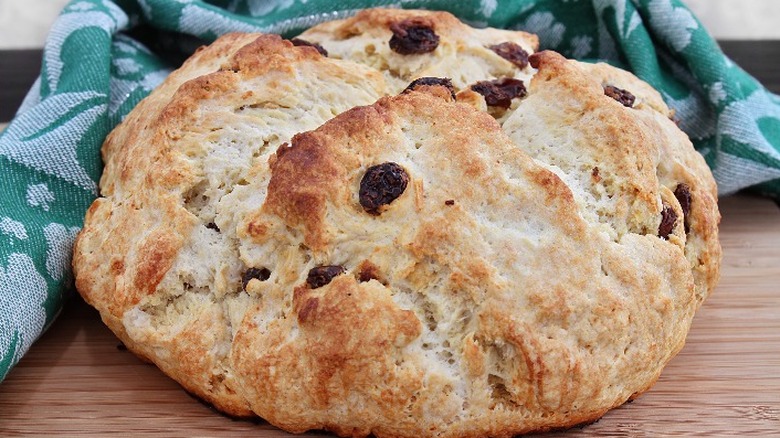15 Traditional Irish Dishes Everyone Needs To Try At Least Once
Ireland and Northern Ireland have long relied on being self-sustaining, with food that needed to be filling, functional, and plentiful. Historically, much of the country worked outdoors doing heavy labor and needed food that was nutrient-dense and hardy enough to keep them going. Large families meant more hands to help but also more mouths to feed. Fishing and farming enabled many families to provide something for their loved ones to eat, and neighbors could trade resources. Like many places, Ireland still holds onto its traditional recipes, reflecting those values.
You'll definitely notice certain foods making an appearance in more than one dish — potatoes, cabbage, mutton (or lamb), seafood, pork, and carrots were all plentiful and made their mark on the nation's culinary identity. These traditional recipes are still enjoyed, with the occasional tweak to modernize them, as a way to celebrate the foods many Irish people grew up with. Read on to discover some of these well-loved dishes you have to try at least once.
Barmbrack
Barmbrack, a sweet bread that has been around since Samhain was first celebrated in pre-Christian Ireland, is still eaten regularly as a tea cake, but once a year it also purports to reveal your future. Often thought of as the Irish fortunetelling bread traditionally served on Halloween, this sweet, yeasted bread has undergone some changes since that time, but it remains a favorite snack in many Irish households. When Barmbrack was strictly made at home, it contained a number of trinkets that would magically predict the next year for whoever received that specific slice. Since bakeries have started selling the bread, the Halloween version now only contains the ring token, but home bakers are encouraged to add the remaining charms.
The bread, also called Báirín Breac, is made without the trinkets the rest of the year and is served slathered with good Irish butter and a strong cup of tea. The name means "speckled bread" because of the addition of dried fruit and spices, giving the loaf its sweet taste and coarse texture.
Black and white pudding
You've likely heard of blood sausage but might not know it by its other name, black pudding. It's called pudding because it's boiled or steamed in a cloth. It's the pudding known as a sweet dessert in North America — these sausages are cooked in animal intestines. Originally, it was a perfect way to use up farm by-products such as pork or beef fat and blood; black puddings also made a filling addition to pre-workday breakfast. The addition of oatmeal and barley helped to stretch the ingredients as well as make it even heartier. Today, it's a staple item in any full Irish breakfast.
But what about white pudding versus black pudding? It's really just the ingredients used. White pudding is also a grain-based sausage and contains nearly everything else that the black variety does, with the exception of blood. This makes a difference in the nutrition of the puddings, as blood contains quite a bit of iron. However, it also imparts a metallic taste that some may find unappealing.
Boiled bacon and cabbage
A humble dish of boiled bacon and cabbage combines a couple of Ireland's favorite ingredients to great effect. While it might sound bland, it's actually made with salted pork shoulder, rather than just a few slices of the bacon that we use in America. The cut of meat is first boiled with onions, carrots, and spices, with the cabbage added for the last 10 minutes of cooking time. The meat is sliced just before serving and covered with a creamy parsley sauce. Often served with colcannon on the side, it's a dish that remains a quintessential Irish dinner to this day.
Like potatoes, you might think that the Irish eat a lot of cabbage. Nutrient-dense and easy to grow, it's been a staple food for a long time... even longer than you might think. In fact, you may be able to thank the ancient Celts for cabbage.
Boxty
With a recipe that is very close to traditional Irish soda bread, boxty is another staple Irish food that is made with few ingredients that were easy enough to find. Potatoes, baking soda, buttermilk, and flour (soda bread eschews potato but adds a dash of salt) come together to make a different type of bread that's actually more like a potato pancake, although dumplings are a common variation, too. Boxty is primarily made of grated potatoes (with the remaining ingredients in there just to hold everything together), unlike potato farls which are made with mashed.
Before you start whipping up the Irish potato pancakes that go with everything, make sure you've got the right ingredients. You're going to need starchy potatoes, like russets, so they really soak up the buttermilk and stay together in the pan. Speaking of the pan, there's an old rhyme about making boxty, "Boxty in the griddle, boxty in the pan, if you can't make boxty, you'll never get a man." Take that as you will, potato lovers.
Coddle
Coddle is a Dublin institution, as far as food goes. You might be asking though, what is Dublin coddle and what does it taste like? Basically, it consists of bacon and sausage, cubed potatoes, chicken or vegetable stock, and onions that are slow-cooked (coddled, so to speak). Often, barley is added or any other veggies you have on hand, like leeks or carrots. One of the most important steps, no matter what you choose to add to your dish, is browning the bacon and sausage before you add the rest of the ingredients. Otherwise, you're missing all the flavor that makes the dish what it is.
It remains one of the foods most associated with Dublin and possibly one of the most controversial. Coddle can be white or brown, depending on your tastes, and people will argue with much vigor that their preference is the better one. The difference between the two really only comes down to the addition of beef bouillon, beef stock, or oxtail soup in the brown version.
Colcannon
Like barmbrack, colcannon is a year-round comestible that's also a simple Irish dish traditionally eaten on Halloween. October 31st has long been considered the one day of the year when spirits could most easily pass through the veil between our worlds. To lure loved ones back home, people prepared all the best foods for Samhain (Halloween) including this comforting dish of mashed potatoes, cabbage, cream, and loads of butter. No cabbage? Other sturdy greens, like kale, are acceptable substitutions, as in this delicious recipe.
If you're not a fan of greens (or you just don't have any), make champ instead. While it used to be made with stinging nettle, champ (or "poundies") is most often made with potatoes, cream, loads of butter, and just a little spring onion for greenery. Both dishes are served mounded on the plate with a small depression on top, sort of like a potato volcano. This depression is used to hold as much butter as possible, making both of these dishes a seriously good way to get your fill of dairy goodness.
Crubeens
This one might not appeal to all our readers but, don't worry, it's even a hit-or-miss in Ireland itself. There's no gentle way to put this... crubeens are nothing more than pig's trotters. This specialty can take a while to prepare if the pigs' feet are first corned (salt-cured), but they can also be slow-cooked or boiled before being breaded and deep-fried. Honestly, this might just be the fried Irish snack that will leave you craving pig's feet.
Like a few other entries on this list, crubeens originally grew in popularity because of the irresistible combination of availability and cheapness. Like offal, trotters are plentiful in farming villages and are sometimes overlooked when placed beside more choice cuts of meat. A little ingenuity (plus a lot of salt and other flavorings) and you've got yourself something meaty and succulent. While crubeens fell out of favor for a while, young Irish chefs are rethinking traditional food and bringing back classics like these.
Farl
Another potato dish? You bet. Spuds have long been an integral part of Ireland's diet and culture for a number of reasons besides their crave-worthy taste. According to Britannica, potatoes are easy to grow in (often poor) Irish soil but also store well for the long term and provide decent, hardy nutrition. They can also be prepared in myriad ways that are, let's face it, incredibly delicious. And farls are just another gleaming example of the potato's versatility.
Similar to boxty, farls are a form of potato pancake that borders on a type of bread, depending on the amount of flour in the recipe. Less flour means a denser and moister farl; add more flour, and you'll get something similar to a scone. Made with mashed potatoes, rather than grated, they are shaped into a flat disc and scored into quarters before baking (although store-bought farls are often rectangular shaped). It's one of the amazing ways to use leftover mashed potatoes if that's something that ever happens to you (it never happens to us, either).
Full Irish breakfast
Much like the full English breakfast, the full Irish was originally a way to gear up for a day's work on a cold, rainy farm but it's now more typically eaten on a leisurely weekend morning. It includes a lot of protein-rich foods, mostly slathered with loads of butter. The full Irish (or full Ulster, in Northern Ireland) consists of a variety of ingredients that would have been easy to find in most farming towns, including rashers, sausage, eggs, mushrooms, tomatoes, black and white pudding, and baked beans.
So what's the difference between a full English and Irish breakfast? Generally, the Irish version doesn't usually have potatoes as part of the morning meal — potato-based bread is often served, but only the English one serves dishes such as bubble and squeak with theirs. The Irish breakfast also tends to use one type of bread, whereas the Brits like a serving of both toast and fried bread. The Irish breakfast will include both black and white pudding, while the British stick to blood sausage.
Goody
The original version of this snack might not be that appealing to someone who is looking for an exciting edible, but most children or anyone unwell in Ireland will have had their fair share of goody. Slices of plain white bread, soaked and boiled in milk (or weak tea if you were lucky!), with the occasional addition of sugar and spices was the original recipe for this little bit of soggy sustenance. Times have changed, however, and goody can now be seen as being a little closer to bread pudding than what it once was. Recent additions of cocoa powder and chocolate chips have brought it back to mainstream audiences, rather than just being used to settle an upset stomach.
Also used to celebrate St. John's Eve (marking the beginning of summer), a heartier version is cooked in one large pot over a bonfire. If you plan on helping yourself to the communal goody, make sure to bring your own bowl and spoon.
Irish moss pudding
The traditional Irish pudding that's made with seaweed might sound dubious, but we swear, it's really rather tasty. Much like panna cotta, Ireland's moss pudding is made with warmed heavy cream, vanilla, sugar, and a thickening agent. Rather than using gelatin, moss pudding makes use of a common ingredient found all along the Irish coastline — carrageen seaweed. Gathered by hand and dried in the sun, the seaweed is revived with hot water before having the gelatinous substance squeezed out and added to the other pudding ingredients. Common flavorings include vanilla, whisky, lemon, chocolate, or anything else that might flavor a sweet, creamy dessert.
Carrageen seaweed has a stunning purple-red shade when first pulled from the sea but after being dried in the sun, it loses most of its color. However, it does retain much of its nutritional content and the moss has been used as a traditional curative for a chest cold, (via Smithsonian Mag). The unflavored pudding itself could be quite bland and was often used as a soothing food.
Irish stew
Irish stew is truly one of the first foods that come to mind when thinking of Ireland. Now made with lamb that is slow-cooked until meltingly tender, the original recipe relied on mutton instead. Ireland has a long history of sheep farming, so recipes using mutton prevailed, rather than beef. For today's home cooks that don't live on a sheep farm or have access to fresh mutton, lamb is an acceptable substitution that won't take nearly as long to cook, either.
Adding potatoes, onions, garlic, Worcestershire sauce, and not much else, the resulting dish is a recipe that you can make any time you're craving a little bit of home-style contentment. The choice of broth depends on your preferences — the beef broth is most often used now because of convenience, but if you have the option to boil down your lamb bones and make stock yourself, you can always give that a try. Although, we definitely think that adding a healthy pour of Guinness will improve any broth that you choose.
Seafood chowder
Another of Ireland's top foods is, of course, seafood. Being an island, fresh catch from the Atlantic ocean is never far away. And an authentic Irish seafood chowder is one of the best ways to make the most of the bounty. But what makes soup different from chowder? Like comforters and duvets, all chowders are soups, but not all soups are chowders. Chowders are generally identifiable by a heavier, creamier base, as well as the addition of large, chunky ingredients like meat and potatoes.
A typical Irish seafood chowder differs from a typical North American-style recipe in that it includes both fresh and smoked seafood, and contains less cream, instead highlighting the flavor of fresh fish broth. After all, as chef Gareth McCaughey points out in an interview with the Toronto Sun, Irish food has always been based on the most plentiful foods. Like many other recipes, seafood chowder will adapt from one area to the next, particularly as you work your way around the coast and the catch of the day changes.
Shepherd's pie
Shepherd's pie is standard comfort food, made with ground lamb, mashed potatoes, and whatever veggies you prefer — most often peas, carrots, or corn. If you were expecting us to tell you that it had ground beef, that's understandable. The North American version is most often made with beef because we eat far more beef than lamb. In the UK, it's only ever called shepherd's pie when it's made with lamb. When it's made with beef, it's actually a cottage pie because, during the 18th century, it was eaten by peasants who mostly lived in cottages, (via Jamie Oliver).
Minced or ground lamb is sautéed with a little onion and chopped vegetables, then spread into a casserole dish. Cover it with a thick layer of mashed potatoes, pop it into the oven, and you're done. It's simple, hearty, and relies on ingredients that most people have on hand, especially in farming communities. The variations that sound pretty delicious include adding a sprinkle of cheese or breadcrumbs over the top of the mashed potatoes before cooking.
Soda bread
Possibly the best-known quick bread to come out of Ireland, soda bread contains no yeast, instead getting its rise from the combination of baking soda and buttermilk. Sometimes containing only flour and salt as the remaining ingredients, soda bread is quick to make and uses few ingredients, something that's still important now. Modern bakers often make use of other ingredients to give the bread a little more oomph — raisins, spices, and sugar, in particular.
It's important to note that the flour used isn't just the hard wheat flour we have access to in North America. The hard-to-find flour Irish soda bread is traditionally made with is called wholemeal and might not be available at your local grocer. Wholemeal flour was used because it was inexpensive, easier to find, and worked exceptionally well without yeast, and in the 200 years it's been around, the recipe has not changed much.
